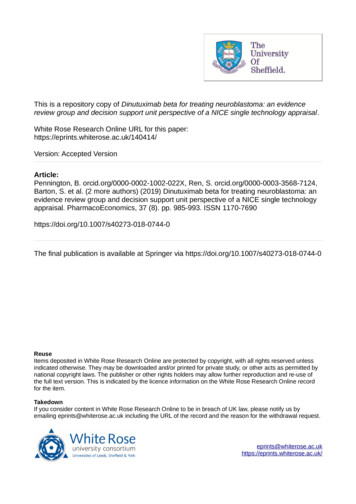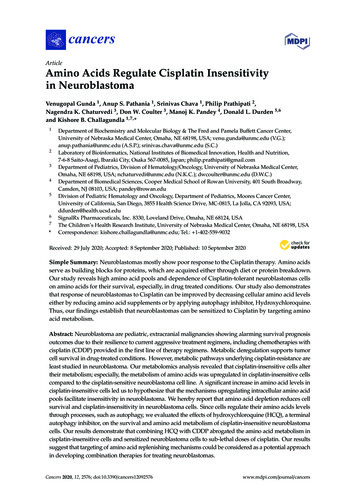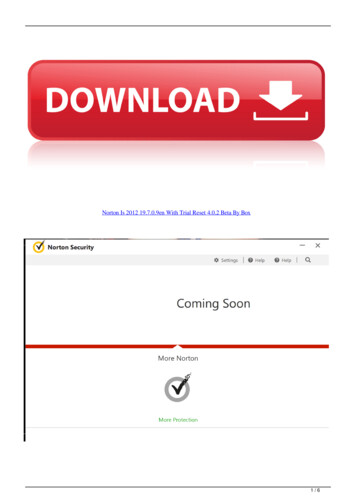
Transcription
This is a repository copy of Dinutuximab beta for treating neuroblastoma: an evidencereview group and decision support unit perspective of a NICE single technology appraisal.White Rose Research Online URL for this on: Accepted VersionArticle:Pennington, B. orcid.org/0000-0002-1002-022X, Ren, S. orcid.org/0000-0003-3568-7124,Barton, S. et al. (2 more authors) (2019) Dinutuximab beta for treating neuroblastoma: anevidence review group and decision support unit perspective of a NICE single technologyappraisal. PharmacoEconomics, 37 (8). pp. 985-993. ISSN The final publication is available at Springer via s deposited in White Rose Research Online are protected by copyright, with all rights reserved unlessindicated otherwise. They may be downloaded and/or printed for private study, or other acts as permitted bynational copyright laws. The publisher or other rights holders may allow further reproduction and re-use ofthe full text version. This is indicated by the licence information on the White Rose Research Online recordfor the item.TakedownIf you consider content in White Rose Research Online to be in breach of UK law, please notify us byemailing eprints@whiterose.ac.uk including the URL of the record and the reason for the withdrawal terose.ac.uk/
TitleDinutuximab beta for treating neuroblastoma: an evidence review group and decision support unitperspective of a NICE single technology appraisalRunning headingDinutuximab beta for treating neuroblastoma: an ERG and DSU perspectiveAuthorsBecky Pennington1Shije Ren1Samantha Barton2Mariana Bacelar2Steven J. Edwards2Affiliations and addresses1. School of Health and Related Research, University of Sheffield, Regent Court, 30 RegentStreet, Sheffield, S1 4DA, UK2. BMJ Technology Assessment Group, BMA House, Tavistock Square, London, WC1H 9JR,UKCorresponding authorBecky Pennington. Email address: b.pennington@sheffield.ac.uk, phone: 0114 222 0745ORCID: 0000-0002-1002-022X1
AbstractAs part of its Single Technology Appraisal (STA) process, the UK National Institute for Health andCare Excellence (NICE) invited the manufacturer (EUSA Pharma) of dinutuximab beta (Qarziba ) tosubmit evidence of its clinical- and cost-effectiveness for treating neuroblastoma. The BMJTechnology Assessment Group (BMJ-TAG) was commissioned to act as the Evidence Review Group(ERG), reviewing the submission from the company. The Decision Support Unit (DSU) wascommissioned to review additional evidence submitted by the company and to undertake furtheranalyses. This article presents the critical review of the company’s submissions by the ERG and DSU,further analyses undertaken by the DSU, and the outcome of the NICE guidance. The clinicaleffectiveness for dinutuximab beta was derived from a phase III randomised controlled trial (RCT)which assessed the safety and efficacy of the addition of interleukin-2 (IL-2) to dinutuximab beta plusisotretinoin. This trial did not inform the relative effectiveness of dinutuximab beta versus isotretinoinalone, which was established practice in the UK for maintenance treatment. In the absence of directevidence, the company initially conducted a naïve indirect treatment comparison against a historicalcontrol, and later performed a matching-adjusted indirect comparison (MAIC) against the isotretinoinarm of an RCT comparing dinutuximab alpha and isotretinoin. The company submitted a partitionedsurvival analysis model that calculated the incremental cost-effectiveness of dinutuximab beta versusisotretinoin. The company’s original incremental cost-effectiveness ratio (ICER) was 22,338 perquality-adjusted life year (QALY) gained. However, the ERG were concerned that the company’sICER was not suitable for decision-making, thus carried initial exploratory analysis as a first step toovercome the naïve estimation of treatment effectiveness in the model. The ERG’s analysis estimatedan ICER of 111,858 per QALY gained. In their revised analysis incorporating the MAIC and otherchanges as requested by the appraisal committee, the company’s ICER was 24,661 per QALYgained. When the DSU incorporated longer-term isotretinoin data and made corrections to the model,the ICER increased to between 62,886 and 87,164 per QALY gained depending on the choice ofsurvival model. A confidential Patient Access Scheme (PAS) decreased the ICERs. The ICERs withthe PAS were over 40,000 per QALY gained, but the NICE committee additionally considered thepatient population and its size, the disease severity, the potential for significant survival benefit and2
uncaptured health benefits, and recommended dinutuximab beta as a treatment option, subject to thecompany providing the agreed discount in the PAS.3
Key Points for Decision Makers There is uncertainty in the clinical- and cost-effectiveness of dinutuximab beta compared toisotretinoin for high-risk neuroblastoma because the clinical evidence relied on a matching-adjustedindirect comparison, in the absence of direct evidence. There are several plausible survival models for extrapolating overall survival and event-freesurvival for dinutuximab beta, leading to uncertainty in the cost-effectiveness analysis. The most plausible incremental cost-effectiveness ratio for dinutuximab beta compared toisotretinoin is above 40,000 per quality-adjusted life year gained, but the committee consideredadditional factors when recommending dinutuximab beta as a cost-effective treatment option.4
1IntroductionThe National Institute for Health and Care Excellence (NICE) provides guidance on the use of healthtechnologies within the National Health Service (NHS) in England. NICE considers the clinical- andcost-effectiveness of a technology within its Single Technology Appraisal (STA) programme[1]. Inthe STA process, the company provides a written submission and executable economic model. Theseare reviewed by an external independent organisation, known as the Evidence Review Group (ERG).The NICE appraisal committee consider the evidence from the company, the ERG report, experttestimony and input from other consultees in developing its preliminary recommendations in theAppraisal Consultation Document (ACD). After publication of the ACD, the company may providefurther analyses for review by the ERG and consideration in developing NICE’s final guidance in theFinal Appraisal Document (FAD). On occasions, the NICE committee may require further evidence inaddition to that presented to the Committee, or beyond the remit of the ERG’s reviewing role. In theseinstances, NICE may commission its Decision Support Unit (DSU) to review and critique additionalevidence from the company, or to undertake new analyses.This paper presents a summary of the ERG[2] and DSU[3, 4] reports for the STA of dinutuximab beta(Qarziba , EUSA Pharma) for neuroblastoma, the NICE guidance development and the keymethodological issues.2Decision ProblemNeuroblastoma is a type of paediatric cancer that arises from the embryonic nervous system.Neuroblastoma is a rare disease, with annual incidence in the UK of between 80 and 100 cases[5].Neuroblastoma is a heterogeneous disease, and children with neuroblastoma are categorised into riskgroups (very low, low, intermediate and high) according to their disease stage[6].Treatment for high-risk neuroblastoma consists of three phases: induction of remission with intensivechemotherapy, consolidation of remission using myeloablative therapy (MAT) and haematopoieticstem cell transplant (SCT), and maintenance therapy with isotretinoin and anti-GD25
immunotherapy[6, 7]. Dinutuximab beta, an anti-GD2 immunotherapy, received its marketingauthorisation for the treatment of high-risk neuroblastoma in children and adults, for the EuropeanUnion in May 2017[8].This STA focussed on the comparison between dinutuximab beta and isotretinoin in patients withhigh-risk neuroblastoma who achieved at least a partial response to induction therapy and who hadMAT and SCT. The NICE final scope defined the population as patients with high-risk neuroblastomawho have had MAT and SCT[9]. The ERG noted that the company considered a slightly narrowerpopulation, as patients had to have achieved at least a partial response to induction therapy. Theintervention, dinutuximab beta, was as per the scope. The scope listed isotretinoin and dinutuximabalpha as comparators, the company included isotretinoin but not dinutuximab alpha as its marketingauthorisation was withdrawn. The ERG agreed with the choice of comparator. Outcomes includedoverall survival (OS), event-free survival (EFS), adverse events (AEs), tumour response and healthrelated quality of life (HRQL). The scope listed subgroups of patients with relapsed or refractorydisease, but the company suggested focussing only on high-risk patients who had not previously haddinutuximab beta, the ERG questioned the relevance of the relapsed or refractory populations andclinical experts confirmed that all UK relapsed or refractory patients would have already receiveddinutuximab beta.3.Clinical and cost-effectiveness evidenceIn this STA, the process was as follows:1. The company submitted its written submission and economic model[10]2. The ERG asked clarification questions of the company[10]3. The company responded to clarification questions and provided revised analyses[10]4. The ERG produced a report reviewing the company’s evidence[10]5. The NICE appraisal committee discussed the company’s evidence and ERG report[10]6
6. The NICE appraisal committee requested further analyses from the company[10]7. The company provided further analyses[10]8. The DSU asked clarification questions of the company[10]9. The company responded to clarification questions[10]10. The DSU produced a report reviewing the company’s further analyses, and conductedadditional analyses[10]11. The NICE appraisal committee discussed the company’s further analyses and DSU report,and developed the ACD[11]12. The company responded to the ACD[12]13. The DSU reviewed the company’s response to the ACD and conducted further analyses[12]14. The NICE appraisal committee discussed the company’s response, DSU report and furtheranalyses and developed the FAD[13].3.1Clinical evidence submitted by the companyThe company provided clinical evidence for the effectiveness of dinutuximab beta in theirsubmission[14]. There was one randomised controlled trial (RCT) in the high-risk population thatincluded dinutuximab beta; APN311-302; but it did not compare dinutuximab beta in combinationwith isotretinoin against isotretinoin alone[15]. APN311-302 was designed to assess the efficacy andsafety of adding interleukin-2 (IL-2) to a regimen of dinutuximab beta plus isotretinoin. APN311-302was an open-label, randomised, phase III multicentre study (including UK), in patients under 21 yearsof age with high risk neuroblastoma, established diagnosis according to the InternationalNeuroblastoma Staging System (INSS), at least partial response to induction therapy and no priorchemotherapy except 1 cycle of etoposide and carboplatin. In APN311-302, 406 patients wererandomised and 180 patients who received dinutuximab beta plus isotretinoin and 190 patients whoreceived dinutuximab beta plus isotretinoin plus IL-2 were included in the analysis. Dinutuximab betawas administered as five 28-day cycles intravenously at a dose of 20g/m2/day over five days, and7
isotretinoin was administered as six 28-day cycles orally at a dose of 160mg/m2/day over 14 days.There was no statistically significant difference in EFS or OS between the two arms at any time point.Three-year EFS was 55.4% for the group not receiving IL-2 and 61.2% for the group receiving IL-2.Three-year OS was 64.1% for the group not receiving IL-2 and 69.1% for the group receiving IL-2.Serious AEs were reported in 46% of patients receiving IL-2 and 27% of those not receiving IL-2,most commonly these were infections, pyrexia, respiratory disorders, gastrointestinal disorders andhypotension. Of the common AEs, 238 patients experienced infections: 106 in the group not receivingIL-2 (including 48 grade 3 and 2 grade 4), and 132 in the group receiving IL-2 (including 60 grade 3and 6 grade 4).In the absence of direct evidence comparing dinutuximab beta to isotretinoin alone, the companyinitially performed a naïve indirect treatment comparison to a historical control of an earlier phase ofAPN311-302 which compared busulfan and melphalan hydrochloride (BuMel) to carboplatin,etoposide and melphalan (CEM) as consolidation MAT, after which 450 patients received isotretinoinalone as maintenance treatment. This was supplemented by a narrative comparison against theisotretinoin arm of an RCT comparing dinutuximab alpha plus IL-2 to isotretinoin in patients withhigh-risk neuroblastoma who had a response to induction therapy and SCT in a study by Yu et al(2010) ([16]). In response to a request from the NICE committee, the company provided anunanchored matching-adjusted indirect comparison (MAIC) comparing the combined dinutuximabbeta arms of APN311-302 against isotretinoin arm in Yu et al (2010). The MAIC adjusted for age,INSS stage, tumour N-myc proto-oncogene protein (MYCN) status and response before SCT.3.2ERG and DSU critique of clinical evidence and additional analysesThe ERG noted that the open-label design of APN311-302 introduced bias, the lack of pre-specifiedtime-point for disease assessment meant that it is unclear whether EFS captured the exact point ofdisease progression, and that the data presented were not the Intention to Treat (ITT) population. Theyfurther noted that the short-term study dosing schedule was unlikely to be in line with clinical practice8
where dinutuximab beta would be given over 10 days and not 5, and that there was a paucity ofevidence regarding the effect of the infusion rate on outcomes. Finally, they noted the immaturity ofthe data for EFS and OS and that, therefore, there is uncertainty in determining the clinicaleffectiveness particularly regarding whether benefit would be maintained in the long term.In their clarification questions, the ERG proposed that a MAIC of the combined APN311-302 datacompared to the isotretinoin arm in Yu et al (2010) was viable and would provide a more robustevidence base than the historical control. This was because the historical control was a retrospectivecollection of data from an essentially non-randomised study, and that the naïve indirect treatmentcomparison was subject to the same potential biases as a MAIC, and from additional confounding dueto imbalance in the prognostic factors and effect-modifying factors.The DSU reviewed the company’s MAIC comparing dinutuximab beta and isotretinoin, andhighlighted errors in the company’s approach. The DSU reported that the number of patients used incalculating the proportions of patients in APN311-302 was incorrect, and ignored that 5 patients’INSS status were unknown in Yu et al (2010), and categorical variables did not all have a referencecase. The company had included the individual patient data (IPD) from APN311-302 in the economicmodel, and so the DSU corrected the errors and re-ran the MAIC. The EFS and OS for isotretinoinand for dinutuximab beta from the observed data and the company and DSU’s MAICs are shown inFigure 1.3.3Cost-effectiveness evidence submitted by the companyThe company developed a partitioned survival analysis model with health states defined as EventFree, Failure and Death. The model had a short-term element, in which the proportion of patients ineach health state was calculated from survival analysis of EFS and OS data, and a long-term element.Patients in the long-term element could not move from Event-Free to Failure, as it was assumed thatpatients who were Event-Free at this point were cured. The time point at which the model changed9
from short-term to long-term was termed the “cure threshold” and was assumed to be 10 years in thebase case. In the long-term model, the mortality of patients in the Event-Free state was 5.6 times themortality for the general population, based on a report from the Childhood Cancer Survival Study[17]and the mortality of patients in the Failure state was 90% higher than patients in the Event-Free state.Through the STA, the company used a number of different approaches to estimate the transitionsbetween states in the short-term model for dinutuximab beta and isotretinoin. Initially, the companyused unadjusted Kaplan–Meier (KM) data for isotretinoin OS from the historical control andestimated EFS KM data, and took a similar approach for dinutuximab beta data. In response to theERG’s clarification questions, the company used Gompertz survival distributions for years where KMdata were not available. As an alternative, the company also provided a hazard ratio for the indirectcomparison of dinutuximab beta versus isotretinoin for OS, adjusted for prior treatment, MYCN, ageand INSS stage at diagnosis. Following the request from the committee to conduct the MAIC, thecompany fitted parametric models to isotretinoin OS and EFS from Yu et al (2010) and matchingadjusted dinutuximab beta OS and EFS from APN311-302. The company used KM data for years 1–6and the Gompertz extrapolation beyond this.The company included common treatment-emergent AEs listed in the Summary of ProductCharacteristics (SmPC)[18] for dinutuximab beta (pain, hypersensitivity, severe capillary leaksyndrome, eye problems, peripheral neuropathy, pyrexia/infection, and vomiting/diarrhoea). Data onthe proportion of patients having AEs were based on a safety database which included high-risk andrelapsed or refractory neuroblastoma patients[14]. In the additional analysis, the company made adistinction between pyrexia and infection and added grade3-4 infection rates based on APN311-302for the group with and without IL-2.The company did not initially specifically model treatment discontinuation, implicitly assuming thatEFS was representative of time on treatment. In later analyses, the company subtracted the proportionof patients discontinuing due to toxicity from the EFS to estimate time on treatment.10
To model HRQL, the company used UK general population norms for EuroQol-5 Dimension (EQ5D)[19] and applied a percentage decrement for having neuroblastoma (the Event-Free state) andrecurrent disease (the Failure state). The company initially used a logistic regression to estimategeneral population norms, but later replaced this with a published algorithm[20]. The decrement forEvent-Free was 12.5%, calculated from the relationship between high-risk neuroblastoma utilities andgeneral population utilities measures using Health Utilities Index (HUI) 3. The decrement for theFailure state was 41.7%, calculated from the relationship between utility for recurrent disease[21] andthe general population[22]. The company did not include utility decrements for AEs, due to a lack ofavailable data.The company included costs for drug acquisition, administration and hospitalisation, concomitantmedication, disease management and AEs, valued at 2016 prices. Drug acquisition costs were basedon unit prices and the number of units consumed based on body surface area (BSA). The companyinitially used the median BSA from APN311-302, but later revised this to use a weighted average costbased on the distribution of patients across BSA categories. The company initially included the costsof concomitant IL-2 for all patients with isotretinoin and dinutuximab beta, which was later removedas there was no anticipated clinical benefit and clinicians advised that IL-2 would not be co-prescribedas standard. Administration costs for dinutuximab beta were initially assumed to involve 7.5 inpatienthospital days for cycle 1 and 2.5 for cycle 2, with the remainder of cycles in an outpatient setting.This was later revised to 10 inpatient hospital days in cycle 1 and 5 in cycle 2. The company includedthe costs for concomitant medication to manage pain and allergic reactions associated withdinutuximab beta treatment. Resource use for the Event-Free state was based on a study of healthcareresource use in the British Childhood Cancer Survivor Study[23] and costed using NHS referencecosts. Costs for the Failure state included treatment with topotecan and cyclophosphamide andfilgrastim – these were initially applied until death, but later revised to be applied for one year,beyond which the resource use for the Event-Free state was applied. Costs for AEs were included,costed using NHS reference costs.11
3.4ERG and DSU critique of cost-effectiveness evidence and additional analysesThe ERG and DSU agreed with the model structure but had concerns about a number of model inputs.The ERG were severely concerned with the estimation of treatment effect, specifically regarding theassumptions used in the initial approach, the survival analysis method used to fit Gompertzdistributions and the use of the naïve indirect treatment comparison.The ERG disagreed with carrying out a naive analysis of treatment effectiveness and felt that thecompany’s model was not suitable for decision making. The ERG undertook an exploratory analysisfor illustrative purpose only, estimating a hazard ratio for isotretinoin EFS and OS relative todinutuximab beta (based on the relationship between dinutuximab alpha and isotretinoin) and usingthe extrapolated Gompertz distribution instead of KM data for dinutuximab beta.The DSU had similar concerns regarding the methods for survival analysis following the MAIC,which used least squares optimisation to fit parametric models. The DSU noted that the ERG hadidentified KM data from a later cut-off of the study comparing isotretinoin with dinutuximabalpha[16] which reported 12 years of EFS and OS data for isotretinoin[24]. The DSU performedsurvival analysis of the MAIC-adjusted dinutuximab beta data – this was not necessary forisotretinoin as the KM data could be used directly in the model with no requirement for extrapolation.In their survival analysis, the DSU considered standard parametric models and flexible spline-basedmodels to allow for more complex hazard functions. According to statistical measures of goodness offit (Akaike Information Criterion (AIC) and Bayesian Information Criterion (BIC)) and visualinspection, the Generalised Gamma, Gompertz, log normal and spline models had the best internalvalidity for OS, and the Generalised gamma and spline models for EFS. Clinical experts advised thatevents after five years would be rare, suggesting that models which flattened somewhat after fiveyears may be most appropriate. The DSU noted that if events after five years were impossible, modelswhich were completely flat after five years would equate to using a five-year cure threshold. Longerterm data for dinutuximab beta were not available, but 12-year data for dinutuximab alpha were[25].12
Given the expected similarities between dinutuximab alpha and beta, the DSU used the shape of thebest-fitting dinutuximab alpha models and the relationship between dinutuximab alpha andisotretinoin to inform model selection[25]. The DSU therefore felt that the Gompertz and spline with2 knots for OS and the Gompertz and spline with 1 knot for EFS should be considered potentiallyplausible. A comparison of the DSU and company’s OS models are presented in Figure 2, and EFSmodels in Figure 3.The ERG had concerns about the source of AE data and whether it was applicable to patientsreceiving dinutuximab beta as a continuous infusion, but found the impact of scenario analysis wasnegligible. The ERG noted that most patients in the SmPC safety dataset received IL-2, and that IL-2increased the risk of AEs. The DSU considered that the company’s adjustment to model infectionrates separately for dinutuximab beta with and without IL-2 was appropriate.The DSU considered that the company’s approach to discontinuation was inaccurate, and preferred touse the proportion of patients treated per cycle reported in APN311-302.The ERG critiqued the cost data, considering a scenario analysis including wastage for gabapentin (aconcomitant medication which excluded wastage) and using the cost of a hospital day forchemotherapy administration rather than chemotherapy procurement costs. The ERG further notedthat treatment in the failure state was likely overestimated as it should only be given until furtherdisease progression or one year[26]. The DSU considered that the company’s revised analysis, whichincorporated these changes, was appropriate.The ERG were concerned about the logistic regression for UK general population utility norms,requesting that the published algorithm[20] be used instead, so the DSU considered that thecompany’s revised analysis using this algorithm was appropriate. The ERG had concerns regardingthe utility decrements, specifically that one study[22] used HUI3 which was not developed for use inchildren, and that this was combined with the HUI2 values in another study[21] when the measuresmay not be comparable. Furthermore, the company’s approach assumed that the populations in thetwo studies were comparable, despite differences in age, and that patients in the second study did not13
have neuroblastoma[21]. Overall, the ERG were unable to draw final conclusions as to which utilityvalues should be used, and considered it a source of uncertainty. The ERG noted that excluding theimpact of AEs on HRQL may overestimate the QALY gain for dinutuximab beta, but considered thatthis impact would be minimal.The ERG corrected the dinutuximab beta administration costs in the model and stated that they wouldhave preferred the drug acquisition costs to use an average number of vials according to thedistribution of BSA, which the company addressed in their revised analysis. Similarly, the company’srevised analysis addressed the ERG’s concerns about the costs of chemotherapy administration andwastage of concomitant medication.The company’s base case incremental cost-effectiveness ratio (ICER) was 22,338 per QALY gainedin their original submission, and the ERG’s corrections increased this to 31,366 per QALY gained.In the ERG’s exploratory analysis, the ICER was 111,858 per QALY gained. After addressing thechanges requested by the appraisal committee, the company’s ICER was 24,661 per QALY gained.Taking into consideration the corrections and revisions made by the company, ERG and DSU, theDSU’s final analysis estimated that the mean deterministic ICER ranged from 62,886 to 87,164(probabilistic: 69,000 to 80,000) per QALY gained depending on the choice of survival model forOS and EFS (Table 1). A confidential Patient Access Scheme (PAS) discount decreased the ICERs.4.Key methodological issuesThe key methodological issues in the evidence base were the indirect treatment comparison andextrapolation of EFS and OS. Naïve indirect treatment comparisons are inherently biased, and while aMAIC can address the bias arising from imbalance in the prognostic factors and measured treatmenteffect modifiers it is not without limitations[27].Extrapolation beyond observed data is uncertain and therefore methods to analyse survival datashould be as robust as possible and alternative extrapolations should be considered. The approachtaken by the company was not transparent, and it transpired, not correct. Extrapolations are less14
uncertain where longer-term data are used. The approach taken by the DSU, using the most recentdata for isotretinoin increased the ICERs substantially. The DSU’s scenario analyses demonstratedthat using alternative plausible survival functions could increase the ICER by over 20,000 per QALYgained.5.NICE guidanceOn 22 August 2018, NICE recommended dinutuximab beta as an option for treating high-riskneuroblastoma in patients aged 12 months and over whose disease has at least partially responded toinduction chemotherapy, followed by MAT and stem cell transplant only if they have not already hadanti-GD2 immunotherapy and the company provides dinutuximab beta according to the commercialarrangement.5.1Consideration of Clinical and Cost-Effectiveness Issues in the Final Appraisal DeterminationThis section presents a summary of the key issues considered by the committee. A full discussion ofall issues is presented in the FAD[13]. The committee felt that the evidence for relapsed or refractoryneuroblastoma was not relevant and focussed only on high risk neuroblastoma.Consideration of clinical effectivenessThe committee concluded that despite the limitations of immature data, lack of fixed cut-off data andpotential biases of the open-label design, APN311-302 represented the best source of evidence fordinutuximab beta, but it did not inform the relative effectiveness of dinutuximab beta compared toisotretinoin. The committee noted that the MAIC showed dinutuximab beta improved EFS and OScompared with isotretinoin, and that the later cut-off of isotretinoin data was most appropriate for thecomparator data.15
The committee noted the non-significant difference for EFS and OS between the groups with andwithout IL-2 in APN311-302, and clinical experts advised that IL-2 would not be used in clinicalpractice. The committee noted that dinutuximab beta was associated with AEs, but that these weremore common when given in combination with IL-2.Consideration of cost effectivenessThe committee accepted the structure of the economic model. The committee noted that the long-termbenefit of dinutuximab beta was uncertain and so considered a range of extrapolations for EFS andOS, noting that Gompertz and Spline models are the most plausible for both. The committee preferreda 10-year cure threshold, but considered a range of thresholds in its decision making. The committeefelt that the cost, ut
Email address: b.pennington@sheffield.ac.uk, phone: 0114 222 0745 ORCID: 0000-0002-1002-022X . 2 . the company included isotretinoin but not dinutuximab alpha as its marketing authorisation was withdrawn. The ERG agreed with the choice of comparator. . was an open-label, randomised, phase III multicentre study (including UK), in patients .










